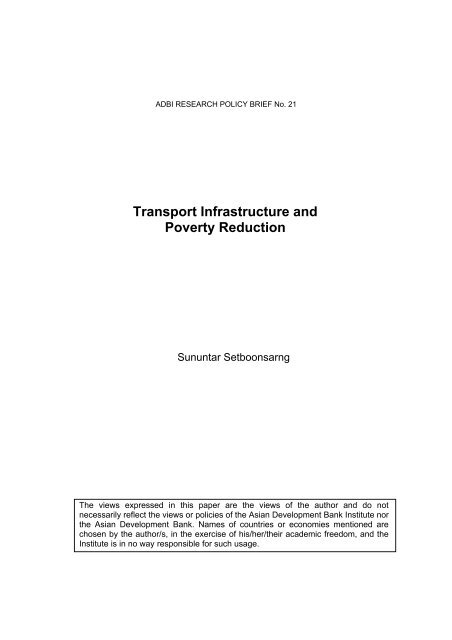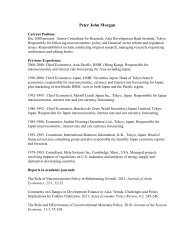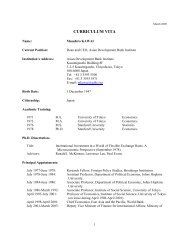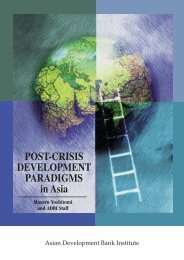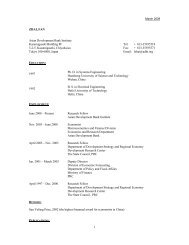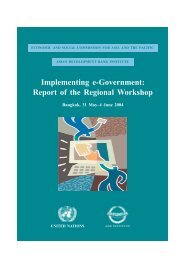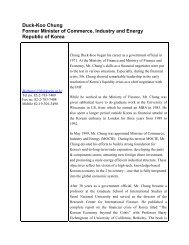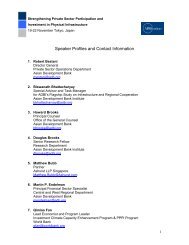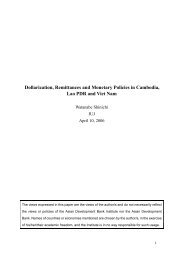Transport Infrastructure and Poverty Reduction - Asian Development ...
Transport Infrastructure and Poverty Reduction - Asian Development ...
Transport Infrastructure and Poverty Reduction - Asian Development ...
- No tags were found...
Create successful ePaper yourself
Turn your PDF publications into a flip-book with our unique Google optimized e-Paper software.
<strong>Transport</strong> <strong>Infrastructure</strong> <strong>and</strong> <strong>Poverty</strong> <strong>Reduction</strong>: Micro-Level ImpactsThe extent to which transport infrastructure can directly contribute to poverty reductionseems to depend on its impact on income <strong>and</strong> non-income dimensions of poverty at themicro-level.In terms of income poverty, transport infrastructure opens up opportunities for the poor toraise the productivity of their limited resources. In rural areas, where most of the poor reside<strong>and</strong> where agriculture remains the main source of income, transport infrastructure lowers thecosts of inputs <strong>and</strong> facilitates access to credit, extension services, <strong>and</strong> most importantly,output markets with better prices. It also facilitates the commercialization of farm <strong>and</strong> nonfarmactivities <strong>and</strong> often leads to agricultural diversification from low-value food grains tomore perishable, high-value agricultural products.An ADB study in 2005 provides empirical evidence to support these theoretical linkages.Based on field research in India, Thail<strong>and</strong>, <strong>and</strong> the PRC, the study finds that rural transportimprovements decreased costs to the poor for personal travel <strong>and</strong> goods transport. Ruraltransport improvements are also revealed to have generated farm income, promoted nonfarmactivities, <strong>and</strong> increased the range of opportunities for wage employment as well as thewage rates of labor in rural areas.In terms of non-income poverty, transport infrastructure can likewise generate directimpacts by lowering the cost of services needed by the poor, <strong>and</strong> by serving as a goodcomplement to interventions that seek to improve access to health, education, <strong>and</strong> othersocial services. <strong>Transport</strong> investments may also play an important role in mitigating risksfaced by poor households.The same study finds that rural transport investments increased the availability <strong>and</strong>accessibility of education <strong>and</strong> health care services in rural areas, resulting in greaterparticipation in these programs by the poor. Rural roads also facilitated the delivery ofemergency relief to the poor in case of natural disasters.For all of these reasons, across Asia <strong>and</strong> the Pacific, the rural poor often give very highpriority to improvements in transport (Rayner, 2005), <strong>and</strong> both the poor <strong>and</strong> non-poor alikesee positive impacts <strong>and</strong> welcome investments in transport infrastructure (Cook, 2005).Who Captures the Benefits of <strong>Transport</strong> <strong>Infrastructure</strong> Investments?Despite evidence confirming that transport infrastructure can contribute to poverty reduction,experience would tell us that this relationship is by no means automatic. In many instances,transport investments have failed to provide benefits for the poor <strong>and</strong> the vulnerable, despiteaggregate gains in productivity <strong>and</strong> income.In countries where the distribution of income <strong>and</strong> opportunities is skewed, in general it isthe non-poor who benefit more from investments. Because they are better endowed, thenon-poor, particularly the larger l<strong>and</strong>owners <strong>and</strong> the vehicle owners/operators, tend todisproportionately capture cost savings as a result of better transport infrastructure.Improvements in agricultural productivity <strong>and</strong> the shift to commercial production have tendedto benefit the larger <strong>and</strong> wealthier farmers who could intensify l<strong>and</strong> use <strong>and</strong> benefitimmediately from improved market access. On the other h<strong>and</strong>, smallholders often requirefurther assistance in coordinating the bulk purchase of inputs <strong>and</strong> the collective marketing ofoutputs. In most cases, this could lead to a worsening of income distribution in the short <strong>and</strong>medium term (Setboonsarng, 2005). Without further assistance, these <strong>and</strong> other benefitssuch as rising l<strong>and</strong> values are typically captured by the local elite. In addition, despite betteraccess to social services due to improved connectivity, the poor’s access to such servicesremains disproportionately low compared to the non-poor (ADB, 2005).33
6. Lack of complementary investments <strong>and</strong> pro-poor policies or interventions in othersectors. <strong>Transport</strong> infrastructure’s contribution to a reduction in non-income dimensionsof poverty will depend on the level of investments <strong>and</strong> the pro-poor nature of policiesgoverning other services that are crucial for empowering the poor. This includes investingin sectors such as health, education, natural resource management, <strong>and</strong> agriculture. Onlywhen sufficient investments are made in these sectors to provide these basic services forthe poor, will transport infrastructure investment bring about significant poverty reduction.7. Lack of awareness on the gender dimensions of transport. Empowering women isanother dimension of poverty reduction that requires more attention. Women, particularlypoor women, are often put at risk by the lack or poor quality of transport services (Cook,2005). Despite improvements in transport modes, women are still likely to suffer fromtransport deprivation: this problem is most prevalent in gender segregated societies,where women are often unable to travel or trade unless there are sections <strong>and</strong> facilities inbuses, trains, boats or waiting rooms that are for women only. While transportinvestments could provide improved connectivity benefits to women, if not well guarded,they can produce unintended detrimental impacts <strong>and</strong> give rise to a host of negativegender outcomes. <strong>Transport</strong> improvements have been implicated in the trafficking of girls<strong>and</strong> women, especially in localities near major highways <strong>and</strong> cross-border corridors(Lateef, 2005).8. Road safety. The poverty implications of road safety have gained increasing attention inrecent years. Investment in transport infrastructure in developing countries is generallynot accompanied by investment in improved road safety st<strong>and</strong>ards. As a result, theincreased volume of traffic often severely affects the security <strong>and</strong> safety of the population.Melhuish (2005) points out that road accidents alone can have significant socioeconomicimpacts on poverty. Citing the results of a study in Bangladesh <strong>and</strong> India, he pointed outthat that the poor suffered disproportionately from a road crash: they bore the biggestlosses in income, <strong>and</strong> the unexpected medical or funeral costs accounted for a largerproportion of household income compared to non-poor households, forcing many to godeeper into debt. Overall, 7 out of 10 households suffered a decrease in total householdincome, <strong>and</strong> many households had to decrease food consumption as incomes declined.Even some households that were not poor before the crash found themselves poorafterwards.9. Unintended negative externalities. There are negative externalities associated withimprovements in transport infrastructure: increased mobility is linked to the spread ofdiseases such as HIV/AIDS; vehicle emissions along with dust generated by un-pavedroads could cause health problems, alteration of water ways brought about by roadconstruction could lead to detrimental consequences on natural resource systems, theemergence of motorized transport could displace labor, as in the case of porters whoused to manually transport goods, <strong>and</strong> out-migration from rural communities could lead toother social problems. Such negative externalities are likely to exact a bigger toll on thepoor rather than the non-poor.6
Improving <strong>Transport</strong> <strong>Infrastructure</strong>’s Direct Impact on <strong>Poverty</strong>In developing countries, extending transport infrastructure to provide universal access willcontinue to be a priority, but at the same time, there is clearly a pressing need to makepoverty reduction an integral part of transport infrastructure policy. Meanwhile, many otherfactors influence the impact of transport infrastructure on poverty reduction, most of whichare exogenous to infrastructure interventions, e.g., macroeconomic conditions such asgovernance, conflict, <strong>and</strong> physical factors such as population, density, resourceendowments, climate <strong>and</strong> terrain. These factors likewise give rise to bottlenecks that preventtransport infrastructure from benefiting the poor, <strong>and</strong> must also be sufficiently incorporated inthe design <strong>and</strong> management of transport infrastructure projects. Some of the more criticalinterventions in this regard include the following:<strong>Poverty</strong> analysisTo be effective in addressing poverty, there is a need to put asserted effort to explicitlyidentifying the poor or disadvantaged groups that will be affected by transport infrastructureprojects; carrying out poverty analysis; <strong>and</strong> incorporating the results of such an analysis intoproject design. Components spelling out explicit activities should be incorporated to ensurethat poverty issues are addressed throughout the project cycle.Choice of investment <strong>and</strong> poverty targetingEquity considerations require some form of targeting <strong>and</strong> prioritization of transportinvestments that have the greatest impact on poverty. For instance, among the differenttypes of transport infrastructure, targeting investments to road infrastructure could make themost sense since it has been highlighted in the past as an important determinant of povertyreduction. Besides addressing the question of what to invest in, there is also the equallyimportant question of where to invest. Given that poverty incidence tends to be higher in ruralareas, targeting rural areas that lack access to basic transport infrastructure <strong>and</strong> servicescan be expected to have the biggest impact on poverty reduction.<strong>Transport</strong> services policyImproving transport infrastructure’s impact on poverty does not only entail physical accessbut affordability as well. This requires ensuring that the poor benefit from savings in operatingcosts, <strong>and</strong> that the resulting change in transport services is affordable to the poor. Here theprimary policy instrument is to ensure effective competition in transport services, allowingoperators to set their own fares <strong>and</strong> new operators to enter the market so that efficiency isencouraged. As Rayner (2005) states: “The lower the level of fare <strong>and</strong> entry regulation, thehigher the chance of infrastructure investment contributing to poverty reduction.”There has been some debate regarding how far the competitive environment can beused to positively influence the distribution of benefits. At the crux of this debate lies thepossible trade off between allowing competition in the transport sector <strong>and</strong> the potential needfor regulation to protect the interest of consumers. The ADB study (2005) reveals that lowcost,publicly provided services that fail to meet minimum st<strong>and</strong>ards of comfort, safety <strong>and</strong>reliability are not highly valued by the poor. In this regard, Rayner (2005) argues that qualityregulation is necessary at all times, to ensure safety st<strong>and</strong>ards.However, quality st<strong>and</strong>ards that are too rigorous could also displace non-motorized orinformal transport services, which are also very important for the poor, particularly those inthe rural areas. Maintaining the informal transport sector can also contribute to direct povertyreduction because it offers income-generating possibilities for the poor. Governments maytherefore need to practice a more tolerant attitude towards these kinds of service providers,without unduly exposing users to safety risks.77
Addressing maintenance issuesQuite obviously, there is a need to discover new approaches that will guarantee a moreappropriate level of investment <strong>and</strong> better implementation of road maintenance. Since projectactivities are more visible <strong>and</strong> easier for donors to finance, one possible way of overcomingpolitical <strong>and</strong> financial constraints could be to re-package or neatly bundle maintenanceactivities into a project. In other words there might be a need to “projectify” maintenance;bundles of activities pertaining to maintenance could be packaged into a project equippedwith all the conventional elements of public projects i.e. project documentation to providedata on the problem area, the course of action required, as well as the rates of expectedreturn. As a project, maintenance activities could become viable to politicians <strong>and</strong> donors(McCawley, 2005).However, the most feasible <strong>and</strong> sustainable solution seems to lie in shifting theresponsibility of maintenance away from the government <strong>and</strong> donors towards greater costrecovery, through mechanisms such as Road Funds, or towards broader participation ofbeneficiaries at the local level. At present, there is very little involvement of beneficiaries whoare often very willing to participate in maintenance efforts, even to the extent of contributingto the cost of maintenance either in cash or in kind. While some might argue that localcontributions could not possibly be sufficient to cover the necessary expenditures,experience tells us that only very small amounts are required initially to meet maintenancerequirements. However, the costs tend to rise rapidly as deterioration progresses, exceedinglocal capacities <strong>and</strong> budgets (ADB, 2002b). Nevertheless, maintenance schemes withparticipation of the private sector in the local communities should be further encouraged.Promoting participatory project design <strong>and</strong> managementBeyond addressing maintenance issues, adopting a participatory process <strong>and</strong> givingbeneficiaries a voice in decision-making should become st<strong>and</strong>ard practice in the overalldesign <strong>and</strong> management of transport projects. Instituting some forms of local participatoryprocess is arguably the best way to ascertain the transport needs of the poor <strong>and</strong> specificsocial groups, such as women, as well as determine the kind of safeguards required by thosewho might suffer negative effects.Providing complementary servicesAll of the measures that have been proposed thus far fall within the ambit of transport sectorpolicy, but it has been demonstrated that transport infrastructure’s impact on poverty isgreatest in the presence of complementary services, which are provided by other sectors.Improvement in physical access should be integrated with other interventions such asschools, health clinics, agricultural support programs, <strong>and</strong> ICT services. This highlights theimportance of cross-sector investment planning.Minimizing the trade-offsDespite the best <strong>and</strong> most well-meaning efforts to make transport investments more propoor,the trade-off between maximizing growth <strong>and</strong> minimizing poverty reduction or the tradeoffbetween providing access/affordability <strong>and</strong> maximizing quality will continue to remainchallenging realities. Experience from PRC suggests that where income distribution isskewed, the choice of investing in rural or low-grade road to benefit the poor may be a moreappropriate choice.On the trade-off between access/affordability <strong>and</strong> quality, it seems that there should bean effort to define a set of minimum st<strong>and</strong>ards <strong>and</strong> regulations that can adequately addressthe needs of the poor. There should be a proper balance between the trade offs betweenaccess/affordability <strong>and</strong> quality, although the combination <strong>and</strong> the balance of the trade offswill tend to differ depending on prevailing conditions.8
Financing of <strong>Transport</strong> <strong>Infrastructure</strong>Faced with persistent fiscal crises <strong>and</strong> slow growth prospects, the past decade has seen adramatic increase in the liberalization of transport policies in developing countries,occasioning a bigger role for private operators <strong>and</strong> investors in transport infrastructure.For the both the government <strong>and</strong> the private sector, this should have meant a change intheir fundamental roles in transport infrastructure provision, <strong>and</strong> to a certain extent, it has, asevidenced by the different modes of public <strong>and</strong> private sector partnerships. However, themovement of private finance into infrastructure has been slow, accounting for only 30 percentof total infrastructure investment, with much of this figure concentrated in a small number ofcountries (Pernia 2003, in Weiss, 2003).Private finance has likewise been problematic. The private sector has no effectivemechanism to deal with issues such as right of way <strong>and</strong> resettlement. In most cases, theprivate sector is interested in investing in transport projects only when they can also benefitfrom l<strong>and</strong> <strong>and</strong> property development along the new transport route. Therefore, private sectorinvestments have been more extensive <strong>and</strong> successful in large urban cities or peri-urbanpopulated areas. The track record of success has been in projects such as mass transitsystems <strong>and</strong> tollroads.Experience points to the fact that government is likely to continue to play a key role intransport infrastructure while new <strong>and</strong> innovative modes of financing will have to be tested.<strong>Poverty</strong> <strong>Reduction</strong> Through Trade Promotion:The Importance of Cross-Border <strong>Transport</strong> <strong>Infrastructure</strong>Thus far, we have looked at the issues surrounding transport infrastructure <strong>and</strong> povertyreduction at the domestic level. However, given increasing globalization, liberalization, <strong>and</strong>changing patterns in trade, providing regional public goods such as cross-borderinfrastructure has become more critical in bringing benefits that may not materialize throughdomestic provision alone. <strong>Transport</strong> projects constitute one logical area for regionalcooperation, considering the impact that infrastructure improvements could have on reducingtrade costs <strong>and</strong> facilitating trade between participating countries (Fujimura, 2004).The case for investing in cross-border transport infrastructure is most compelling forsmall countries like Cambodia, Laos, <strong>and</strong> Myanmar, or countries in Central Asia that aremoving from a transition to a market economy. Since they are l<strong>and</strong>-locked <strong>and</strong> far frommarkets, these countries have common elements that are motivating them to cooperate(Wescott, 2005).However, the success of cross-border transport projects will depend on the extent towhich they are able to meet three overriding challenges, as identified by Wescott (2005):First, since several countries are involved in the endeavor, these countries have to agreeon a common framework. Transactions such as these take longer <strong>and</strong> cost more. It isimportant that governments be aware of this upfront, to avoid frustration.Second, in many cases, it has also been difficult to get countries on board because thereis a lack of convincing evidence on the potential benefits of cross-border infrastructureinvestment. In a framework of benefit-cost analysis, costs have been easier to estimate sincethis only requires taking account of material investment cost <strong>and</strong> financing cost but collectinginformation on benefits to different countries under various stages of development is far morecomplicated. Empirical studies approximating the benefits from cross-border transportinfrastructure will be necessary to encourage participating countries to increase the amountof cross border infrastructure investment.Finally, at present, cross-border transport projects are underfunded. The financingrequirements are far more than ADB <strong>and</strong> other development agencies can meet <strong>and</strong>99
governments have a difficult time gathering enough resources to support regional projects.Multilateral donors also lack suitable financing <strong>and</strong> supplements for funding regional projects.The main instruments that multilateral financial institutions such as ADB have are loans thatrequire sovereign guarantees of member counties. The whole process of financing regionalprojects requires a coordinated allocation of responsibility among the countries as well asparticipating donor agencies. Coordination will be essential, particularly when there is a needto combine three or four different loans for different nations entailing different sovereignagreements for each loan. In theory grant funds would be appropriate for investmentsbecause grant funds will not require sovereign guarantees from involved governments.However, there is a limited amount of grant funds to cover current financing needs.Areas for Future ResearchDespite recent studies on the subject, the knowledge base linking infrastructure to povertyreduction remains limited. This entails bridging the remaining knowledge gap on the impactsof sector policy change, impacts of changes in service provision, impacts of transport modesother than roads, impacts on the urban poor, <strong>and</strong> the importance of rural-urban linkages.There is a need to have a better underst<strong>and</strong>ing of the notion of poverty reduction, thedistribution of benefits between the poor <strong>and</strong> non-poor, <strong>and</strong> measures to include the poor indecision making process. The research needs also extend to issues related to privatization<strong>and</strong> regulation of transport infrastructure, innovative road maintenance scheme, <strong>and</strong> theindirect effects of larger infrastructure investments on poverty.Finally, efforts to promote cross-border transport projects will have to be supported withempirical studies which approximate the benefits to encourage participating countries toincrease the amount of cross boarder infrastructure investment.10
ReferencesMajority of these references <strong>and</strong> conference presentations are on the CD-ROM <strong>and</strong> alsofreely available in full text online at www.adbi.org.ADB 2002a. Impact of Rural Roads on <strong>Poverty</strong> <strong>Reduction</strong>: A Case Study-Based Analysishttp://www.adb.org/Documents/PERs/IES_RuralRoads.pdfADB 2002b. Grant Assistance (Financed By The Japan Fund For <strong>Poverty</strong> <strong>Reduction</strong>) to theDemocratic Socialist Republic of Sri Lanka for Supporting <strong>Infrastructure</strong> Maintenance toReduce Rural <strong>Poverty</strong>. http://www.adb.org/Documents/JFPRs/SRI/jfpr_sri_35399.pdfADB 2005. Assessing the Impact of <strong>Transport</strong> <strong>and</strong> Energy <strong>Infrastructure</strong> on <strong>Poverty</strong><strong>Reduction</strong> http://www.adb.org/Documents/Reports/Assessing-<strong>Transport</strong>-Energy/Cook,. Cynthia 2005. ‘Joining the Mainstream: Impact of <strong>Transport</strong> Investment on <strong>Poverty</strong><strong>Reduction</strong>—RETA 5947.’ Presented at the ADBI Workshop on <strong>Transport</strong> <strong>Infrastructure</strong><strong>and</strong> <strong>Poverty</strong> <strong>Reduction</strong>, ADB Manila, 18–22 July 2005.Duncan, Tyrrell 2005. ‘Assessing the Impact of <strong>Transport</strong> <strong>Infrastructure</strong> on <strong>Poverty</strong><strong>Reduction</strong>—Some Reflections on RETA 5947.’ Presented at the ADBI Workshop on<strong>Transport</strong> <strong>Infrastructure</strong> <strong>and</strong> <strong>Poverty</strong> <strong>Reduction</strong>, ADB Manila, 18–22 July 2005.Fujimura, Manabu 2004. ‘Cross-Border <strong>Transport</strong> <strong>Infrastructure</strong>, Regional Integration <strong>and</strong><strong>Development</strong>.’ ADB Institute Discussion Paper No.16.Hettige, Mala 2005. ‘From Rural Roads to <strong>Poverty</strong> <strong>Reduction</strong>: Links <strong>and</strong> Channels.’Presented at the ADBI Workshop on <strong>Transport</strong> <strong>Infrastructure</strong> <strong>and</strong> <strong>Poverty</strong> <strong>Reduction</strong>,ADB Manila, 18–22 July 2005.Kwon, Eunkyung 2005a. ‘<strong>Infrastructure</strong>, Growth <strong>and</strong> <strong>Poverty</strong> <strong>Reduction</strong> in Indonesia: ACross-Sectional Analysis.’ Paper presented at the ADBI Workshop on <strong>Transport</strong><strong>Infrastructure</strong> <strong>and</strong> <strong>Poverty</strong> <strong>Reduction</strong>, ADB Manila, 18–22 July 2005.------ 2005b. ‘Road <strong>Development</strong> <strong>and</strong> <strong>Poverty</strong> in the People’s Republic of China.’ Presentedat the ADBI Workshop on <strong>Transport</strong> <strong>Infrastructure</strong> <strong>and</strong> <strong>Poverty</strong> <strong>Reduction</strong>, ADB Manila,18–22 July 2005.Lateef, Shireen 2005. ‘Gender in Road <strong>Infrastructure</strong>.’ Presented at the ADBI Workshop on<strong>Transport</strong> <strong>Infrastructure</strong> <strong>and</strong> <strong>Poverty</strong> <strong>Reduction</strong>, ADB Manila, 18–22 July 2005.McCawley, Peter 2005. Comments delivered at the ADBI Workshop on <strong>Transport</strong><strong>Infrastructure</strong> <strong>and</strong> <strong>Poverty</strong> <strong>Reduction</strong>, ADB Manila, 18–22 July 2005 (Panel Discussion,22 July).Melhuish, Charles 2005. ‘Road Safety <strong>and</strong> its Socioeconomic Impact on the Poor.’ Presentedat the ADBI Workshop on <strong>Transport</strong> <strong>Infrastructure</strong> <strong>and</strong> <strong>Poverty</strong> <strong>Reduction</strong>, ADB Manila,18–22 July 2005.Puri, B.N. 2005. Comments delivered at the ADBI Workshop on <strong>Transport</strong> <strong>Infrastructure</strong> <strong>and</strong><strong>Poverty</strong> <strong>Reduction</strong>, ADB Manila, 18–22 July 2005 (Panel Discussion, 22 July).Rayner, Nigel 2005. ‘The Importance of <strong>Transport</strong> Services for <strong>Poverty</strong> <strong>Reduction</strong>.’Presented at the ADBI Workshop on <strong>Transport</strong> <strong>Infrastructure</strong> <strong>and</strong> <strong>Poverty</strong> <strong>Reduction</strong>,ADB Manila, 18–22 July 2005.Setboonsarng, Sununtar 2005. ‘Impact of Rural Roads in Agrarian Reform Communities.’Presented at the ADBI Workshop on <strong>Transport</strong> <strong>Infrastructure</strong> <strong>and</strong> <strong>Poverty</strong> <strong>Reduction</strong>,ADB Manila, 18–22 July 2005.Warr, Peter 2005. ‘Road <strong>Development</strong> <strong>and</strong> <strong>Poverty</strong> <strong>Reduction</strong>: The Case of Lao PDR.’ ADBInstitute Discussion Paper No. 25.Weiss, John 2003. ‘<strong>Infrastructure</strong> Investment for <strong>Poverty</strong> <strong>Reduction</strong>: A Survey of Key Issues.’ADB Institute Research Policy Brief No. 5.1111
Wescott, Clay 2005. ‘Regional Cooperation <strong>and</strong> <strong>Transport</strong>.’ Presented at the ADBI Workshopon <strong>Transport</strong> <strong>Infrastructure</strong> <strong>and</strong> <strong>Poverty</strong> <strong>Reduction</strong>, ADB Manila, 18–22 July 2005.12


